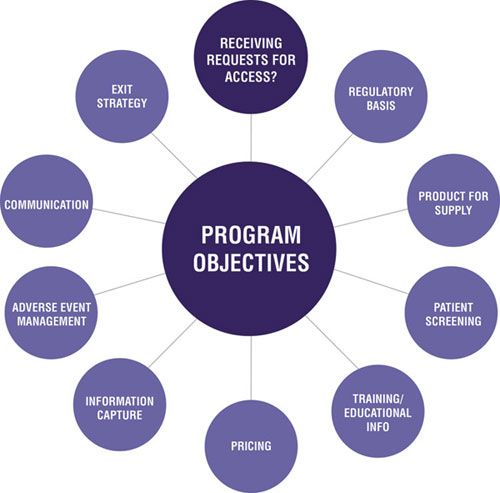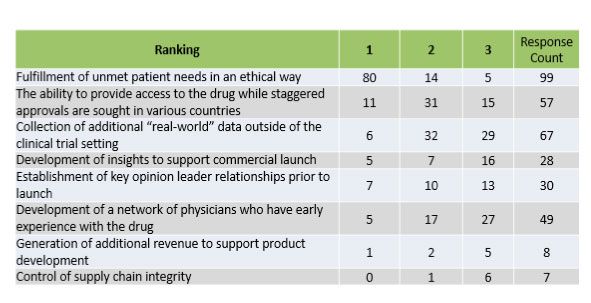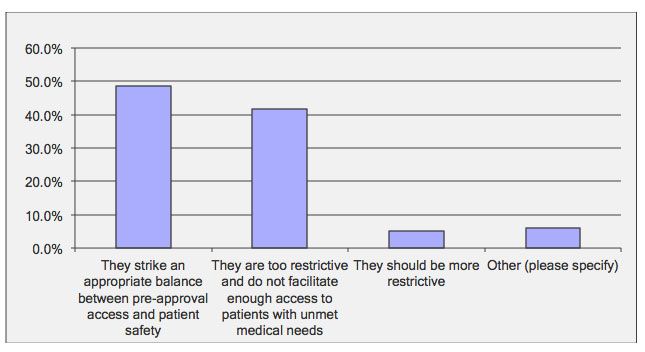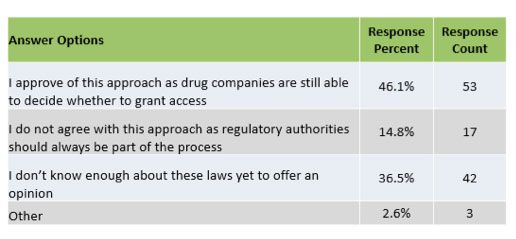Expanded Access: Get Ready
While the initiation and management of an access program can be challenging and requires careful assessment and planning, the benefits to patients, healthcare providers and sponsoring companies are immeasurable, writes Rob Fox. “Patients will find you.”In his keynote address at this year’s World Orphan Drug Congress, Henri Termeer, the former CEO, chairman and president of Genzyme reminded the audience that patients will actively seek out companies developing new therapeutics for their unmet medical needs.
While the initiation and management of an access program can be challenging and requires careful assessment and planning, the benefits to patients, healthcare providers and sponsoring companies are immeasurable, writes Rob Fox.
“Patients will find you.”
In his keynote address at this year’s World Orphan Drug Congress, Henri Termeer, the former CEO, chairman and president of Genzyme reminded the audience that patients will actively seek out companies developing new therapeutics for their unmet medical needs.
Countless patients around the world, not just those with rare diseases, face a difficult path when they exhaust all available treatment options for serious or life-threatening diseases or conditions. Too often, these patients cannot wait for promising new medicines to be approved and commercialized.
What had once seemed like a dead end to many patients however, may no longer feel like the end of the road.
Expanded access programs (known by many terms around the world including named patient programs and compassionate use) can provide an ethical and regulatory-compliant solution. Such programs offer a mechanism by which patients with unmet medical needs may gain access to medicines that are not commercially available in their country.
The primary objective for implementing such programs must always be to provide access for patients with unmet medical need. However, in doing this these programs also provide opportunities for Pharma companies to:
- Ensure all requests for access for both ‘eligible’ and ‘non-eligible’ patients are responded to in a compliant, consistent and timely manner
- Ensure treating physicians are correctly educated about appropriate and safe use of the product
- Gather “real world” data about the use of a drug in a wider population
Interest and attention to these programs has clearly reached a tipping point across many stakeholder groups including industry and regulatory authorities. Consider recent efforts in the United States to facilitate access as well as decisions regarding who gets access:
• In February 2015, FDA issued a new form intended to significantly reduce the amount of time required by physicians to request expanded access for patients, from 100 hours to less than one. The FDA has a strong record of approving access requests.
• A bill currently in Congress would create the Andrea Sloan Compassionate Use Reform and Enhancement (CURE) Act. The bill, named after Andrea Sloan who died after unsuccessfully seeking access to a drug to treat her ovarian cancer, would require companies to provide FDA and patients more information about how they deal with requests for expanded access.
• As of March 2015, thirty-six states have filed bills or have passed “right to try” laws and that permit manufacturers to provide patients with investigational drugs on an emergency basis without going through the FDA’s expanded access process. Critics and supporters of the effort abound and yet it remains the choice of the pharmaceutical company whether they will provide access.
• The pharmaceutical division of Johnson & Johnson recently established an independent, ten member bioethics panel consisting of physicians, patient advocates and ethicists who will be tasked with evaluating requests from patients for drugs that have not yet received FDA approval.
The pathway to access is also evolving in countries around the world. In 2014, the Early Access to Medicines scheme was introduced in the UK. Overseen by the Medicines and Healthcare Products Regulatory Agency (MHRA), the scheme enables patients to try medicines that may not be clinically proven to be effective but are considered safe. Regulations governing compassionate use were also updated by the Belgian government in 2014.
In 2012, the Japanese government announced plans to adopt a “compassionate use” system, which will allow patients to use medical treatments not yet approved in Japan. The proposed guidelines are still in under review and is unlikely to be published before the end of 2015.
Despite efforts to define and streamline the process for access outside the clinical trial and commercial framework, there can be confusion and frustration among patients and a perception remains among some in industry that the programs are complicated or risky.
In the context of a rapidly evolving environment and amid vocal stakeholders, now is the time for pharmaceutical companies to establish their policy related to access programs and become increasingly proactive in considering if, when and how to implement these programs. The final decision on whether to grant access rests with these companies. As a result, they should make a commitment to understand these programs and offer them in the appropriate circumstances.
While the benefits these programs offer stakeholders is clear, demand for access can come at a time when other activities are consuming internal resources such as execution of pivotal clinical trials or gaining of market authorization. Furthermore, the skills, experience, and infrastructure necessary to implement and manage a successful access program vary significantly from those required for clinical trial execution. The regulatory environment presents its own challenges, with regulations often poorly defined and with considerable inter-country variation.
In order to ensure the successful development and implementation of a program, safeguard patients and mitigate risk, a number of factors must be considered. Figure 1 summarizes the range of considerations that must be taken into account to help ensure a successful access program.

Companies should produce a comprehensive, product-specific, country-by-country plan for access that includes how the program will be implemented and managed along with the exit strategy, for all relevant geographies. This guidance document or standard operating procedure should include details of when programs need to be considered (phase in development, therapy area, patient population), who will be the decision makers and governance bodies, how and by whom a program should be implemented, how often individual project strategies should be reviewed and budgetary considerations.
The exact type and scope of any access program will depend on expected demand, regulatory feasibility, the license status of the product, necessary drug pricing structure, as well as company strategy, costs, and product supply.
Among the biggest challenges involved in establishing an access program is understanding global regulations. There are distinct routes to achieve access worldwide and regulatory mechanisms vary considerably from country-to-country. The regulations also define whether and how a company can charge for medicines supplied under such access programs.
Given this complexity, the regulatory environment for the specific product should be assessed during the initial planning phase for an access program, and should consider the following factors:
• License status of the product (completely unlicensed, licensed in the country in question but not commercially available, not licensed in the country in question but licensed in another country, withdrawn)
• Patient population (ex-clinical trial patients, new patients, patients not meeting eligibly criteria of ongoing trials)
Assessment of the regulatory environment for a product will, for example, identify countries where supply is not possible or instances where more than one potential route for access exists, requiring a choice between a single-patient or cohort approach. In these instances, the sponsor may often have a preference on the regulatory route to use, depending on other factors such as pricing structure, pharmacovigilance capabilities in the country, product availability, and labeling and set-up times and costs.
Once the access program is launched, ongoing management is required to ensure successful delivery. This will include monitoring of stock levels, resolution of any issues, and, in particular, management through key lifecycle milestones such as approvals in the US or EU, commercialization in each country, extension to new countries, variations to drug product used, changes in pricing strategy, and, of course, the program exit strategy at its conclusion.
Conclusion
While the initiation and management of an access program can be challenging and requires careful assessment and planning, the benefits to patients, healthcare providers and sponsoring companies are immeasurable. Well-run programs provide an ethical and regulatory-compliant pathway for access to new treatments by patients with serious conditions and unmet medical needs. These programs also enable the building of relationships with prescribers, provide the opportunity to gather valuable “real world” data and can help address any challenges prior to the product being commercially launched.
We expect the focus on these access program will continue to intensify. As a result, drug companies will be well-served by proactively structuring their approach to requests for access, rather than waiting for the phone to ring.
In March 2015, Clinigen conducted a survey* of pharmaceutical industry professionals to gauge sentiment on programs that allow access to drugs prior to approval or commercialization. Below, we share highlights of the results.
What your Peers are Saying about Access Programs
Do you expect requests by patients and physicians for access to drugs in the pre-approval stage to increase or decrease in the coming years?

What factors are driving the expected increase in demand?
Slow approvals
Advocacy
Development of drugs for “niche” populations
Greater awareness
What are the primary benefits of providing access to drugs prior to approval? (Indicate top 3)

What is your opinion regarding your government’s regulations allowing pre-approval access?

What is your opinion of the new “right to try” laws?

*Survey conducted in March, 2015
Participants: Readers of Fierce Markets online publications
115 Responses
Organization type
• Pharma/biotech 99
• Government 2
• Consulting 1
• Other 13
Geography
• North America 85.2%
• EU 7.8%
• Rest of world 7.0%
About the Author
Rob Fox (rfox@idispharma.com) is Vice President Global Business Development, Idis Managed Access. He works within the global business development team consulting with pharmaceutical and biotech companies to identify and implement strategic solutions to meet their global access needs.
Addressing Disparities in Psoriasis Trials: Takeda's Strategies for Inclusivity in Clinical Research
April 14th 2025LaShell Robinson, Head of Global Feasibility and Trial Equity at Takeda, speaks about the company's strategies to engage patients in underrepresented populations in its phase III psoriasis trials.
Applying Porter’s Five Forces to Portfolio Management in Pharmaceutical R&D: A Strategic Roadmap
March 17th 2025The increasing costs and complexity of R&D in the pharmaceutical industry have necessitated the adoption of strategic portfolio management to optimize resource allocation and enhance competitive advantage.